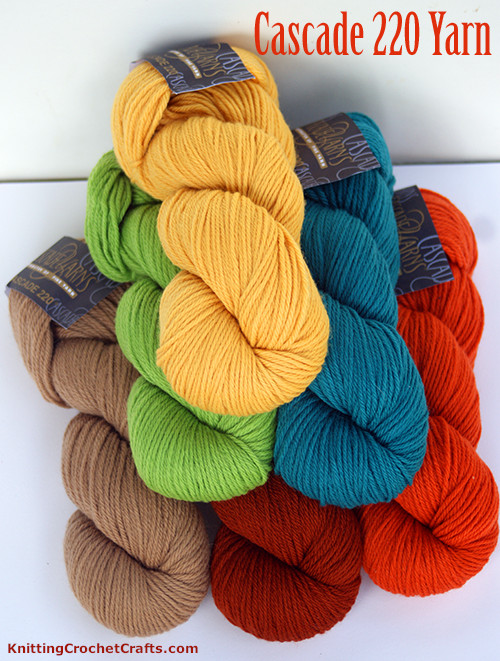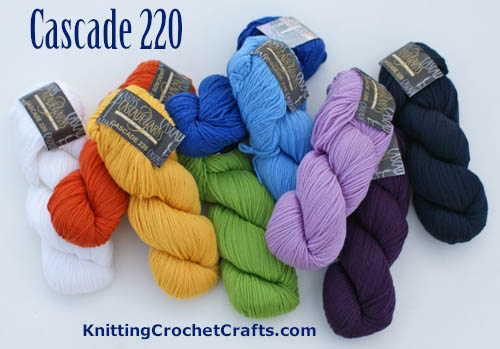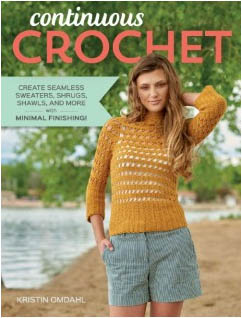A Yarn Review of Cascade 220 Wool for Knitting and Crochet

Here you can see some, but not nearly all, of the color line that is available for Cascade 220 worsted weight wool yarn. Cascade 220 is THE YARN I recommend for beginners to work with, because it is highly resilient, forgiving of mistakes, affordable and comes in an impressive range of colors.
Cascade 220 is the yarn I use most often for knitting and crochet projects. I haven’t yet had the opportunity to weave or do macrame with Cascade 220, but I think it would also work well for either of those purposes.
Please note that Cascade 220 is available in multiple thicknesses and finishes. On this page, I’m reviewing the classic worsted weight Cascade 220 wool yarn, NOT the Superwash or the fingering weight. The same review is applicable to the solid and heathered colors of the yarns, which I use in my projects interchangeably.
The Color Palette: Cascade 220 Wool Yarn by Cascade Yarns

Cascade 220 Worsted Weight Wool Yarn
The color palette for Cascade 220 yarn is truly spectacular. It is an extensive and ever-changing color line. The folks at Cascade yarns do an impressive job of keeping the color line up to date; they often release new yarn colors to keep up-to-date with color trends. In my opinion, the yarn’s massive, well-curated color palette is one of its top selling points (but not by any means the only selling point).
If you want to make a project that requires specific and sometimes hard-to-find colors, you’ll probably want to reach for Cascade 220 as your go-to yarn for that purpose. Let’s say, for example, you want to make a sunflower crochet project. You’d automatically have to reject the vast majority of yarns being manufactured right now, because most of them don’t make a sunflower yellow or a rich brown color available. In contrast, Cascade 220 gives you excellent choices for both the yellow and the brown yarns you’d want to use in your sunflowers.
Pictured above are several different colors of Cascade 220 worsted weight wool yarn. This is not the complete color line – not even close to it.
Please note: I have tried to represent the colors as accurately as possible in these photographs; however, since browsers all display colors a bit differently, and individual computer monitor settings vary, it is impossible for me to guarantee that you’re viewing the colors with total accuracy.
Skein Weight : 100 grams / about 3.5 ounces
Skein Yardage: 220 yards /about 201 meters
My Experiences Crocheting and Knitting With Cascade 220 Yarn by Cascade Yarns — Cascade 220 is the yarn I reach for most frequently when I start a new crochet or knitting project. It is THE YARN I use for just about everything.
Why?
Well, for starters, I used to live aboard a sailboat – and not a sailboat that stayed docked in a marina. For most of the time we lived aboard our boat, we didn’t even have a slip to put our boat in. So I lived in a sailboat that was constantly in motion. Most of the time, we were in a different place every week.
A sailboat in constant motion = death to yarns that pill when agitated. If you want to check in a hurry whether your yarn will pill or not, toss a skein of it to a cruising sailor. On a cruising sailboat, you have the opportunity to find out fast how well any given yarn will hold up over time. Most yarns, quite simply, do not. They’re a mess by the end of one month, and sometimes it doesn’t even take that long to make a mess of them.
Cascade 220 wins the prize for the yarn that held up best during the course of my travels. It’s a yarn that felts, but in my experience, it only felts when you really want it to. When we were underway, some other competing yarns (Patons Classic Wool, for example) felted themselves in my drybags before I had a chance to make anything with them. Which is not to say that Patons Classic Wool is a bad yarn; in fact, I’d expect any feltable yarn that’s subjected to that kind of agitation to felt. It’s a mystery to me why Cascade 220 didn’t do the same, as I’ve found that Cascade 220 readily felts every time I’ve wanted it to do so.
Patons Classic Wool is an okay yarn; I like it and recommend it. But, since Patons Classic Wool doesn’t have the AMAZING color palette that Cascade 220 does, and it doesn’t stand up to the same level of abuse that Cascade 220 does, I stopped buying it. I much prefer Cascade 220.
When I want to design a new project, or make another designer’s pattern, Cascade 220 nearly always wins my attention over other competing wool yarns – because Cascade 220 offers both the colors and durability I need. And because it’s also affordable, too. And because it’s warm and practical. And because the quality control is unheard of – I think I’ve found, maybe, one flaw in the last 20+ skeins of Cascade 220 I’ve used up. It is really, really rare to find flaws in the yarn.
Most knitters, crocheters and weavers will never subject their yarns to the abuse that I do as a cruising sailor. But if you want my opinion on which yarn wins the trophy for standing up to abuse like a champ, Cascade 220 would be that yarn. Let me tell you, I have put the yarn through unheard of abuse – and not just from the sailboat. While we’ve been out cruising, there have been times when I haven’t had access to any yarn suppliers, so I’ve unraveled and re-knit the same skein of yarn multiple times — and it still held up well to that challenge.
For that reason, Cascade 220 is the yarn I always recommend to beginning crocheters and knitters. There are a LOT of yarns out there that either can’t easily be unraveled or don’t look as good after having been unraveled and re-knit. Cascade 220 performs like a champ when you need to fix mistakes in your work. It also resists splitting, which is an issue new crocheters sometimes have a hard time with.
The projects I’ve made with Cascade 220 have turned out beautifully, and all the ones I still own have held up well with time. (I give away most of what I make, so I’m honestly not sure how all my projects have fared.)
So far I’ve used Cascade 220 for making hats, scarves, cowls, fingerless gloves, blankets, afghans, headbands, baby projects, felted crochet potholders and crochet flowers. Note that, while I LOVE IT for baby projects, I am big on hand washing my laundry in buckets. Not everyone shares my enthusiasm for bucket laundry. The only time I’d recommend washing the non-superwash version of Cascade 220 by machine is if you’re intentionally trying to felt it – which is something you might want to do with potholders and certain other types of projects.
Things to Be Aware of Before You Buy This Yarn: There are no downsides to Cascade 220 that I’m aware of. However, one single yarn cannot be all things to all people. For some people, there may be a couple of deal breakers with this yarn. The first: It is NOT MACHINE WASHABLE. You will need to hand wash the projects you make with this yarn. BUT there is a Superwash version of the yarn which can be washed — and that’s what you should buy if washability is important to you.
The second thing you’ll want to be aware of: This yarn is soft and lovely, but it is NOT the softest wool yarn in existence. So if you’re looking for more of a luxurious knitting or crochet experience, this yarn would probably not be your first choice. Having said that, Cascade 220 is waaaaaayyyyyyyyyyyyyy more luxurious than your average acrylic such as Red Heart Super Saver. Unlike acrylic, it’s also biodegradable — which is a HUGE consideration if you’re making projects that will eventually go outdated and get thrown away.
The same cannot be said of a project you make using acrylic yarn. Acrylic is a type of plastic. It might not feel like plastic when you knit with it or wear it, but chemically, it performs like other plastics do. If you make a project with acrylic yarn, after you tire of it or it gets too shabby to continue using, it will hang around in the landfill forever. Not only that, it will most likely continue to offgas toxic fumes forever, for as long as it exists.
Hands down, Cascade 220 is the yarn I knit and crochet with most frequently. Overall, I think you’ll have a hard time finding a better quality yarn for the price. I highly recommend this yarn.
Where to Buy Cascade 220 Yarn:
.
Free Crochet Patterns Featuring Cascade 220 Yarn:
- Christmas Gift Basket: Free Crochet Pattern
- Lace Crochet Wreath Ornament for Christmas: Free Pattern
- Free Crochet Daisy Flower Pattern
- Rainbow Tapestry Crochet Scarf: Free Pattern
- Easy Openwork Crochet Headband Pattern for Beginners
Buy Crochet Patterns Featuring Cascade 220 Yarn:

Continuous Crochet by Kristin Omdahl, Published by Interweave — 2 of the 21 crochet patterns in this book feature Cascade 220 as the suggested yarn.
Continuous Crochet by Kristin Omdahl is a crochet pattern book published by Interweave. The theme of the book: “Create seamless sweaters, shrugs, shawls and more with minimal finishing! These projects are made using the join-as-you-go technique.
Cascade 220 is the recommended yarn for 2 of the 21 crochet projects in this lovely book. One of the projects is a hat called the “Rhythm and Blues Flower Scalloped Hat. The other is a cowl called the “Laguna Surf Wavy Striped Cowl”. Both designs look as if they’d be warm, practical projects. Both projects, plus all the others in the book, include symbol crochet charts and written-out text instructions. The book features truly outstanding design work that I think you’ll LOVE.
Want more details?
So there you have it: That’s what I know about Cascade 220 wool yarn by Cascade Yarns. This yarn carries my highest possible recommendation; I’ve been crocheting and knitting with this yarn since 2009, and I highly recommend Cascade 220 for both knitting and crocheting.
Find More Reviews of My Favorite Yarns:
More Yarn Info:
This page was last updated on 9-29-2021.